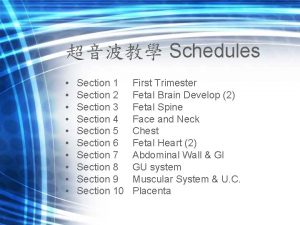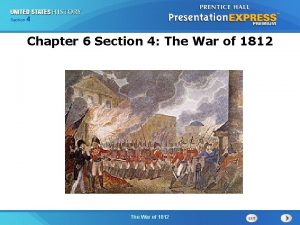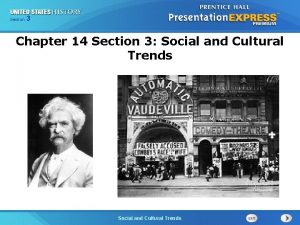Chapter Section 1 25 Section 1 Chapter 6


















- Slides: 18

Chapter Section 1 25 Section 1 Chapter 6 Section 1 The New South The Cold War. The Begins New South

Chapter Section 1 25 Section 1 How did the southern economy and society change after the Civil War? The Cold War. The Begins New South

Chapter Section 1 25 Section 1 Objectives • Explain how the southern economy changed in the late 1800 s. • Analyze how southern farmers consolidated their political power. • Describe the experience of African Americans in the changing South. The Cold War. The Begins New South

Chapter Section 1 25 Section 1 Terms and People • cash crop – crop such as cotton and tobacco that is grown not for its own use but to be sold for cash • Farmers’ Alliance – network of farmers’ organizations that worked for political and economic reforms in the late 1800 s • Civil Rights Act of 1875 – law that banned discrimination in public facilities and transportation The Cold War. The Begins New South

Chapter Section 1 25 Section 1 In the years following the Civil War, southern leaders hoped to build a “New South. ” They worked to modernize the economy by: • supporting industries • diversifying agriculture The Cold War. The Begins New South

Chapter Section 1 25 Section 1 Railroad construction boomed. New rail lines connected urban hubs with rural areas, cities with towns. • Railroads moved people and products. • Cities grew. The Cold War. The Begins New South

Chapter Section 1 25 Section 1 Railroads as of 1870 throughout the US. Railroads as of 1890 throughout the US. The Cold War. The Begins New South

Chapter Section 1 25 Section 1 Textile factories and lumber mills sprang up. So did iron, coal, and steel processing plants. The Cold War. The Begins New South

Chapter Section 1 25 Section 1 As a result, cities begin to grow The Cold War. The Begins New South

Chapter Section 1 25 Section 1 The Cold War. The Begins New South

Chapter Section 1 25 Section 1 Yet economic expansion in the South lagged behind the rest of the country. • War damage was extensive. • The South lacked a well-trained labor force, and wages were low. • A lack of capital led to a dependence on northern bankers. The Cold War. The Begins New South

Chapter Section 1 25 Section 1 Life was especially difficult for southern farmers. Despite efforts to diversify, most farmers still depended on cash crops. The price of cotton— their main crop— plummeted after the war. The Cold War. The Begins New South

Chapter Section 1 25 Section 1 Along with falling prices, cotton farmers faced another disaster. Boll weevils wiped out entire crops. For many farmers, it was a struggle just to survive. The Cold War. The Begins New South

Chapter Section 1 25 Section 1 Faced with serious problems, farmers joined together to form the Farmers’ Alliance. • Worked to negotiate better prices on supplies, freight charges, and loan rates • Connected farmers in the South and West The Cold War. The Begins New South

Chapter Section 1 25 Section 1 Black southerners made important political and economic advances in the postwar years. Most important, they gained: • the right to vote • access to education The Cold War. The Begins New South

Chapter Section 1 25 Section 1 In time, however, many of the gains were reversed. • Groups such as the Ku Klux Klan terrorized African Americans. • Newfound freedoms were stripped away. • Segregation was enforced. The Cold War. The Begins New South

Chapter Section 1 25 Section 1 The Civil Rights Act of 1875 banned discrimination in public facilities and transportation. The Supreme Court, however, ruled in a series of cases decided in 1883 that such decisions were local issues. Southern towns and cities used the ruling to further limit the rights of African Americans. The Cold War. The Begins New South

Chapter Section 1 25 Section 1 Most freed slaves become sharecroppers The Cold War. The Begins New South
 Section quick check chapter 10 section 1 meiosis answer key
Section quick check chapter 10 section 1 meiosis answer key Revolved section drawing
Revolved section drawing Revolved sectioning
Revolved sectioning Symbol of section line
Symbol of section line Work and energy section 2 describing energy
Work and energy section 2 describing energy Chapter 17 section 3 world history
Chapter 17 section 3 world history Chapter 30 section 2 world history
Chapter 30 section 2 world history What was the counter-reformation?
What was the counter-reformation? Chapter 10 section 2 central america and the caribbean
Chapter 10 section 2 central america and the caribbean Unit 14 lesson 1 drivers ed
Unit 14 lesson 1 drivers ed Chapter 19 section 4 wilson fights for peace
Chapter 19 section 4 wilson fights for peace Chapter 15 section 1 types of waves answer key
Chapter 15 section 1 types of waves answer key Chapter 24 section 2 watergate answers
Chapter 24 section 2 watergate answers Chapter 11 section 4 using water wisely answer key
Chapter 11 section 4 using water wisely answer key We think we are using water wisely because
We think we are using water wisely because Acdc copyright
Acdc copyright Examples of economic protest parties
Examples of economic protest parties Chapter 28 section 4 turmoil and change in mexico
Chapter 28 section 4 turmoil and change in mexico Chapter 14 section 2 totalitarianism
Chapter 14 section 2 totalitarianism



































